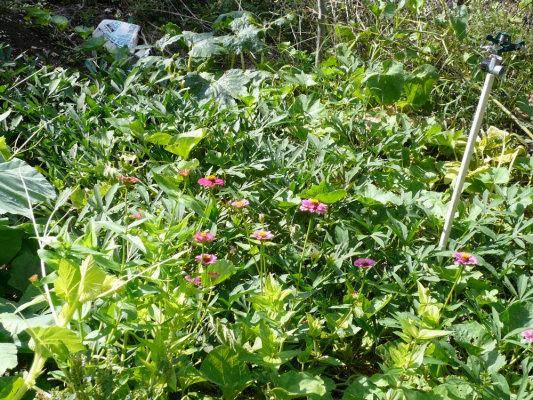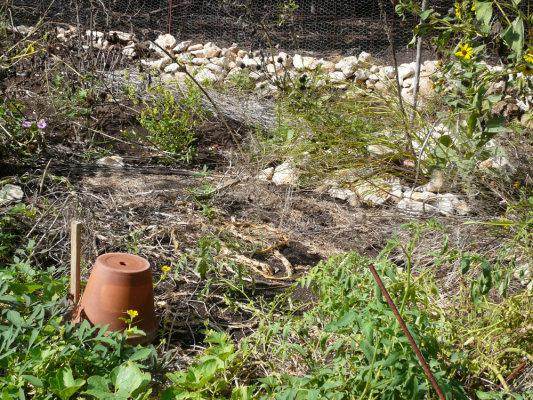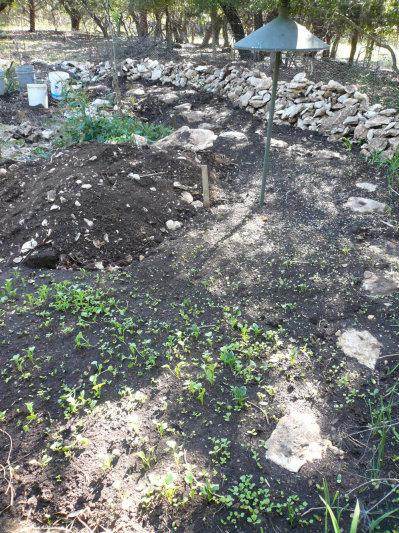





http://www.greenshireecofarms.com
Zone 5a in Central Ontario, Canada





http://www.greenshireecofarms.com
Zone 5a in Central Ontario, Canada





http://www.greenshireecofarms.com
Zone 5a in Central Ontario, Canada




johnlvs2run wrote:
Do rocks have any place in hugelkultur?
Frank Fekonia did something similar with rocks in the bottom 1/3 of old fridges.
http://www.youtube.com/watch?v=62ge_AqaVtM
Could someone comment on the relationship between using rocks plus organic matter as he did,
compared to using wood in hugelkultur, and might there be some benefit to using both wood and rocks?




Brenda
Bloom where you are planted.
http://restfultrailsfoodforestgarden.blogspot.com/




Pakanohida wrote:
I have to drive into town to watch YouTube. but it sounds to me from your description that he basically made a hydroponic system.
However, if I was to venture a guess, it also sounds like he was making a quasi-trickle filter that are used in fish aquaculture systems for private and commercial use. In which, the organic matter breaks down slowly and makes Ammonia. Bacteria that colonizes rocks or other substrate breaks the ammonia down into nitrite and then nitrate and then finally down to free nitrogen and oxygen. Is that what you were looking for?
how to convert a chest freezer to a fridge
Where liberty dwells, there is my country. -- Benjamin Franklin




"the qualities of these bacteria, like the heat of the sun, electricity, or the qualities of metals, are part of the storehouse of knowledge of all men. They are manifestations of the laws of nature, free to all men and reserved exclusively to none." SCOTUS, Funk Bros. Seed Co. v. Kale Inoculant Co.




- Glenn -












Idle dreamer




Brenda Groth wrote:
the backhoe guy that is putting the pond scum in my woods has also knocked over several trees and is burying them under the pond scum and the dirt that he is bringing into my woods..that I wrote about and showed pictures of on that thread mentioned above.
so this area that appears flattish..now..is buried trees under about 2' deep of pond scum, algae, seaweed, clay, dirt, micro organisms..etc..
this might work in the same manner..with the trees rotting from below and the good stuff (giant compost pile) working from above..
too bad it hadn't stopped right here..but there is still more going in there..more scum..more dirt..more whatever..and will be for 2 or 3 more days..it has been going on all day..
we told him to go ahead and knock over and bury some of the dying aspens if he needs the room..but we flagged trees that we wanted to save..
here is a look at the far corner of the woods where it isn't getting filled..
[/img]
the trees were healthier on this side..
the opening to where the area is getting filled in is to the south..so the area will get sun for the middle part of the day..i'm thinking once this area is repaired and levelled..and the stuff settles and begins to decompose (if it needs to decompose..it is mostly rotten already from being in the bottom of the pond???) then it would be a good place to plant something ???
I'm not sure what will go there now..directly in front of this woods are 3 baby walnut trees that are doing very well..only a foot or so tall..so whatever gets put in here will have to put up with walnut trees within 40' of it..but..i have my list of things that will grow near walnuts..
this was totally unexpected..the scum in the woods..my husband arranged that this morning without my knowledge..so it is a new idea..what will happen with dead trees and pond scum
Lawrence London
lfljvenaura@gmail.com
EcoLandTech
http://ecolandtech.blogspot.com
http://ibiblio.org/ecolandtech




Ken Peavey wrote:
N
While the initial bed would see the wood consuming some N, this would be bacterial activity. Once the N is depleted, do those bacteria die off allowing fungi to take over? The fungi would release N from the wood and the wood would capture whatever N leaching out of the soil above. N is retained rather than lost or depleted. This line of thinking could use further development and understanding.
Mycorrhiza Activity
Fungi would be the dominant component of decomposition of woody debris, with mycorrhizae finding an optimum environment. While the pH would tend to be less acid, making P less available to plants, mycorrhizae would be able to chelate nutrients in areas where the pH is not ideal for the plants. The range of pH in which plants could thrive would be greatly expanded. The plants provide sugars to the fungi, the fungi provide the plants with mineral nutrients. It does not matter that the plants cannot access the nutrients in the rotting wood, the fungi will spoon feed it to the plants. I think the involvement of mycorrhizae in hugelkulture is a key aspect to how it works.
Compost Amendment
When burying the wood, I think adding some amount of compost would provide the source of fungi which innoculates the hugel bed.
Lawrence London
lfljvenaura@gmail.com
EcoLandTech
http://ecolandtech.blogspot.com
http://ibiblio.org/ecolandtech




Lawrence London
lfljvenaura@gmail.com
EcoLandTech
http://ecolandtech.blogspot.com
http://ibiblio.org/ecolandtech





http://www.greenshireecofarms.com
Zone 5a in Central Ontario, Canada




Travis Philp wrote:
I did build my hugelbeds on a slight downward slope to allow for some drainage for the reasons you speculate about dirtfarmer. I can't answer for the clay issue because the soil in my hugelbeds is fit for a sandbox.
My understanding is that at least for the first few years, there are so many air pockets between the branches and trunks, that it keeps things from going anaerobic. Not sure though.
Lawrence London
lfljvenaura@gmail.com
EcoLandTech
http://ecolandtech.blogspot.com
http://ibiblio.org/ecolandtech





Idle dreamer




Ludi wrote:
How does one tell if the beds are anaerobic?
Lawrence London
lfljvenaura@gmail.com
EcoLandTech
http://ecolandtech.blogspot.com
http://ibiblio.org/ecolandtech




Idle dreamer








ediblecities wrote:
Our soil is crap and I know that we have to buy stuff

how to convert a chest freezer to a fridge
Where liberty dwells, there is my country. -- Benjamin Franklin
 1
1




ediblecities wrote:Do you remove the topsoil first together with the lawn?
How thick do you cover the twigs with topsoil?....I know that we have to buy stuff, but the amounts mentioned would be a fortune.
What would you recommend?
"the qualities of these bacteria, like the heat of the sun, electricity, or the qualities of metals, are part of the storehouse of knowledge of all men. They are manifestations of the laws of nature, free to all men and reserved exclusively to none." SCOTUS, Funk Bros. Seed Co. v. Kale Inoculant Co.








Joel Hollingsworth wrote:
You are in luck if there is a rock quarry anywhere near you and you can hire a trucker to bring you many tons of siltation pond fines (finely ground rock dust). If the material is clean and the rock does not have toxic components then you are good to go.
Excavate your garden beds (just the beds, nothing else) to a depth of no less than one foot and no more than two feet and create little drainage outlets to prevent standing water. You can use the excavated dirt to build Huguelkulture beds for other types of food gardening and/or landscaping. Fill these wide trenches with the rock dust your trucker brings you. Pile the rock dust in these beds to at least one foot or more (16-18" is great) above existing grade; it will settle out later on. Mix in rock phosphate, azomite, maybe hi-cal limestone, maybe dolomitic limestone, maybe aragonite, maybe limited quanities of wood ashes, greensand, alfalfa meal, granulated seaweed, compost, manure, aged horse manure, organic manures of any kind, aged sawdust or shavings, aged hay, woods mold or earth and landscape waste including rotted leaves. Till everything in by hand or with tillage implement, level the bed and plant it. Mulch with compost or sheet compost it with cover crop planted.
If you later double dig these beds the you will increase fertility and tilth of soil to an even greater depth, improving the impermeable subsoil below the rock dust topsoil.
I have done all of the above though my soil is highly permeable and fertile with good friability and tilth; even better now after addition of rock dust and compost.
Lawrence London
lfljvenaura@gmail.com
EcoLandTech
http://ecolandtech.blogspot.com
http://ibiblio.org/ecolandtech








ediblecities wrote:
Dirtfarmer, why do you suggest an ordinary double dug raised bed instead of huegelkultur? (before we moved I only had very ordinary beds, not raised or something, but it was hotter and drier there).
I really don't like big machines in our yard, but I might hire an excavator doing the job as our soil is incredible crappy fill with tons of stones. I put in some fruit trees and it took me several weeks of labour to get the crap our (and that's the reason why our compost is gone).
The huegelkultur would suit me because we have heaps pf twigs branches and the like.I contacted some lawn mowing companies yesterday and I got the first lawn cuttings delivered today. This let me hope for plenty of lawn cuttings, however they are not composted.
But I must think about the drainage of the whole thing, huegel or not, I have never dealt with drainage problems. I only know that we might simply dig a pond and funnel the water in there.

Lawrence London
lfljvenaura@gmail.com
EcoLandTech
http://ecolandtech.blogspot.com
http://ibiblio.org/ecolandtech




"the qualities of these bacteria, like the heat of the sun, electricity, or the qualities of metals, are part of the storehouse of knowledge of all men. They are manifestations of the laws of nature, free to all men and reserved exclusively to none." SCOTUS, Funk Bros. Seed Co. v. Kale Inoculant Co.









http://www.greenshireecofarms.com
Zone 5a in Central Ontario, Canada









http://www.greenshireecofarms.com
Zone 5a in Central Ontario, Canada




hardly ever leave the farm- don't want to- the internet saves me a million road, air and sea miles, provides at least 25 extra lifetimes, connects to friends who can stay on the subject, and gives me access to the brightest people conscious......
http://www.gardenfarm.biz





http://www.greenshireecofarms.com
Zone 5a in Central Ontario, Canada









http://www.greenshireecofarms.com
Zone 5a in Central Ontario, Canada





Idle dreamer








ediblecities wrote:some good draining material like pebbles or smaller stones. In the middle bottom part you insert a pipe and funnel the water out to a pond (that must be dug as well) . this pond should have an overflow that it cannot fill the whole area.
"the qualities of these bacteria, like the heat of the sun, electricity, or the qualities of metals, are part of the storehouse of knowledge of all men. They are manifestations of the laws of nature, free to all men and reserved exclusively to none." SCOTUS, Funk Bros. Seed Co. v. Kale Inoculant Co.








Joel Hollingsworth wrote:
By contrast, you can talk to people who've put gravel at the bottom of some flowerpots, not in others, and compared the results: the consensus seems to be that any better drainage is very temporary.
find religion! church
kiva! hyvä! iloinen! pikkumaatila
get stung! beehives
be hospitable! host-a-hive
be antisocial! facespace




Rick Freeman
Interface Forestry, l.l.c. http://interfaceforestry.com
Forest and Stand Inventory and Assessment
Wildfire Fuels Management
Watershed Planning and Stand Planning
Wildlife Habitat Improvement
Recreation and Natural Interpretation Planning
Eco-Wise Residential Planning and Wildland-Urban Interface Forestry
Non-Timber Forest Products
rick@interfaceforestry.com

|
What kind of corn soldier are you? And don't say "kernel" - that's only for this tiny ad:
Rocket Mass Heater Resources Wiki
https://permies.com/w/rmh-resources
|








